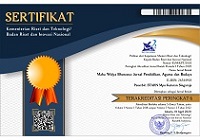BELAJAR MATEMATIKA SEKOLAH DASAR MELALUI TEKS CERITA NARATIF DI MASA PANDEMI COVID-19
Sari
Learning mathematics in the midst of the Covid-19 pandemic has become more difficult than before. Learning mathematics is not enough just to give routine questions to count algorithmically. Certain strategies are needed in presenting mathematics learning, such as giving story questions. Story questions can be divided into routine questions and non-routine questions. Both types of story questions can be developed by incorporating adverbs of time, so that narrative story questions are formed. So from this narrative story problem also develops students' language skills. Language skills are also needed in understanding math problems. With narrative story questions, students' thinking can be directed according to the plot of the story presented. In addition, students can also be given assignments, namely posing problems in the form of simple narrative story questions that are initiated by a stimulus from the teacher. As a accompaniment impact, narrative text writing skills can also be developed.
Teks Lengkap:
PDFReferensi
Agusti, R., R, S., & Hakim, R. (2021). Peningkatan Kemampuan Menulis Narasi Berbasis Pendekatan Kontruktivisme di Sekolah Dasar. Jurnal Basicedu, 5(2), 930942. https://doi.org/10.31004/ basicedu.v5i2.820
Annisah, S., & Masfiah, S. (2021). Pembelajaran Online pada Masa Pandemi Covid-19 Meningkatkan Kesulitan Belajar Matematika pada Siswa Sekolah Dasar. Jpsp, 1(1), 6170.
Ariani, Y., & Kenedi, A. K. (2018). Model Polya Dalam Peningkatan Hasil Belajar Matematika Pada Pembelajaran Soal Cerita Volume Di Sekolah Dasar. Jurnal Inspirasi Pendidikan, 8(2), 2536. https:/ /doi.org/10.21067/jip.v8i2.2520
Cahyani, A., Dewi, N. K., & Setiawan, H. (2021). Analisis Kesalahan Berbahasa Tulis Pada Teks Narasi Siswa Kelas V
SDN 13 Manggelewa Kabupaten Dompu. Pendagogia: Jurnal Pendidikan Dasar, 1(1), 4149.
Dharma, I. A., Suarjana, I., & Suartama, I. K. (2016). Analisis Kemampuan Menyelesaikan Soal Cerita pada Siswa Kelas IV Tahun Pelajaran 2015 / 2016 Di SD Negeri 1 Banjar Bali. E-Journal PGSD Universitas Pendidikan Ganesha, 4(1), 3 10.
Guntara, I. W., Murda, I. N., & Rati, N. W. (2014). Pengaruh Model Pembelajaran Problem Posing Terhadap Hasil Belajar Matematika di SD Negeri Kalibukbuk. Journal Mimbar PGSD Universitas Pendidikan Ganesha Jurusan PGSD, 2(1), 19.
Maarif, H. (2015). EKSPERIMENTASI PROBLEM BASED LEARNING DAN CIRC DALAM MENYELESAIKAN SOAL CERITA MATEMATIKA SISWA KELAS 5 SD Pendidikan Guru Sekolah Dasar FKIP UKSW Salatiga. 97115.
Mulyati, T. (2016). Kemampuan Pemecahan Masalah Matematis Siswa Sekolah Dasar. EduHumaniora | Jurnal Pendidikan Dasar Kampus Cibiru, 3(2). https:// doi.org/10.17509/eh.v3i2.2807
Shanti, W. N., Sholihah, D. A., & Martyanti, A. (2017). Meningkatkan Kemampuan Berpikir Kritis Melalui Problem Posing. LITERASI (Jurnal Ilmu Pendidikan), 8(1), 48. https://doi.org/10.21927/ literasi.2017.8(1).48-58
Sri Anitah, W. (2019). Strategi Pembelajaran Muhadatsah. In (2008) Strategi Pembelajaran. In: Strategi Pembelajaran Bahasa Indonesia. Universitas Terbuka, Jakarta, pp. 1-30. ISBN 9796899590 (Vol. 2, Issue 1, pp. 122). https://doi.org/ 10.24090/tarling.v2i1.2226
Supinah, & Sutanti, T. (2010). Program bermutu. Pembelajaran Berbasis Masalah Matematika Di SD. Yogyakarta. PPPPTK Matematik.
DOI: https://doi.org/10.55115/bhuwana.v4i2.1599
Refbacks
- Saat ini tidak ada refbacks.












.png)
.png)